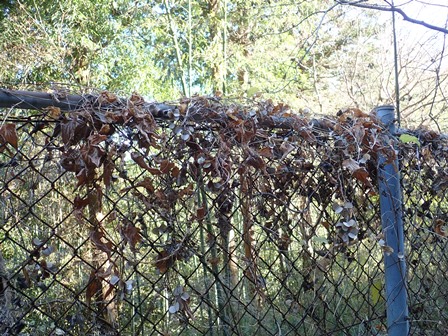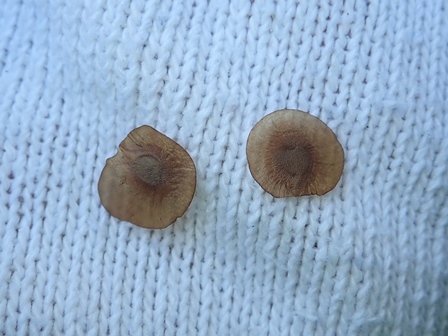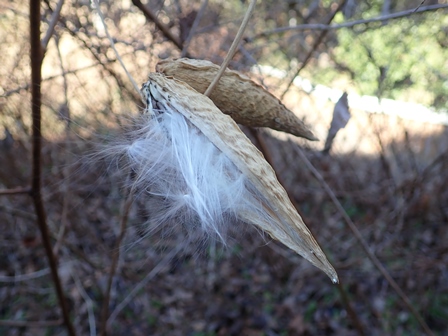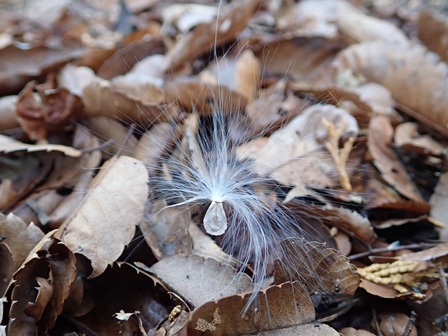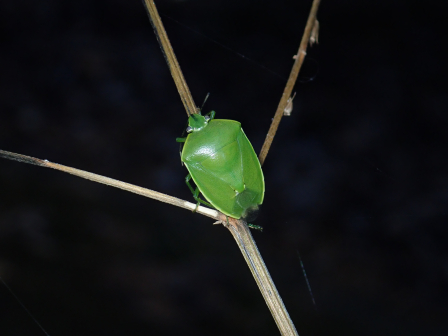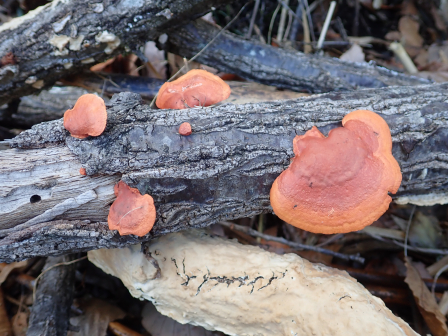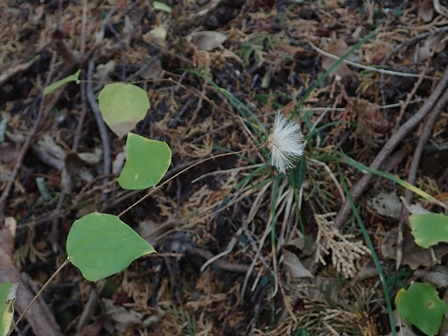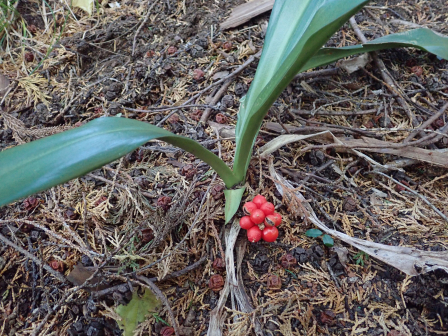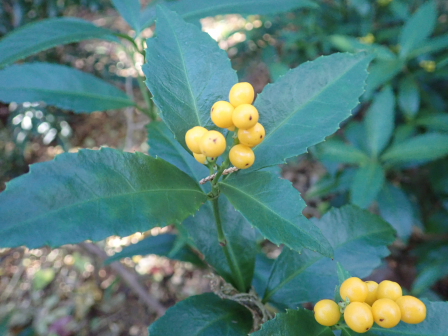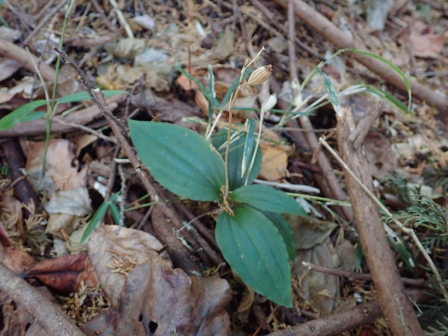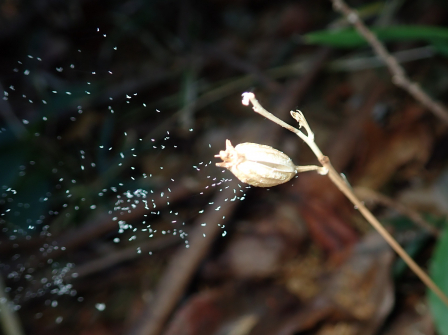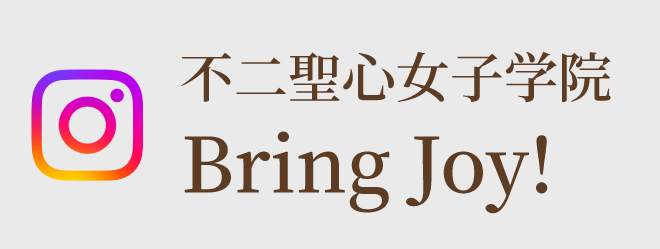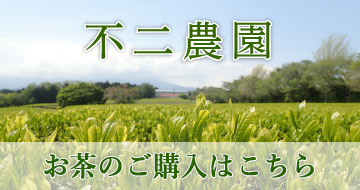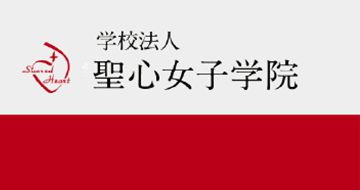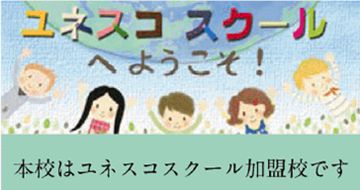フィールド日記
2022年01月
2022.01.28
ヤマノイモ
裏道のフェンスにヤマノイモが巻き付いていました。茎の太さを見ると、地下には大きなイモ(自然薯)がありそうです。イモは1m以上に成長することもありますが、イモは1年生で、毎年新しいイモに作り替えられています。
下の写真はヤマノイモの種子です。種子には翼がついていて、風に乗って運ばれます。
I found a "Yamano-Imo (ヤマノイモ)" plant vine twining on the fence in the back road. Seeing the thickness of the vine, a large tuber should be under the ground. The tubers called "Jinenjo (自然薯)" are edible. Their tubers can grow more than 1m in length, but they are dead and the new ones grow every year.
The second photo shows the seeds of the "Yamano-Imo" plants. The seeds are broadly margined by the wing.
2022.01.25
ガガイモ
ガガイモの果実が熟し、種子が出てきていました。
2022.01.21
ツヤアオカメムシ
裏道でツヤアオカメムシを見つけました。名前の通り緑色で光沢があるのが特徴です。果実の汁を吸う害虫としても知られています。成虫で越冬します。
I found a "Tsuya-Ao-Kamemushi (ツヤアオカメムシ)" stink bug on the back road. The name means "shiny green stink bug" and actually they are. They are also known for pests on fruit. They stay over the winter as adults.
2022.01.18
ヒイロタケ
セカンドオークヒルでヒイロタケが発生していました。名前の通り、鮮やかな赤色のキノコです。通年みられるキノコで、広葉樹の枯木上に発生します。白色腐朽菌に分類され、リグニンを分解し、木材を白色に腐らせます。
"Hiiro-Take (ヒイロタケ)" mushrooms are growing in the Second Oak Hill. The name means "scarlet mushroom" and it comes from their bright red color. They grow on dead broadleaf trees throughout a year. They are classified as a white-rot fungus and they decompose lignin. The wood rotten by this fungus turns white.
2022.01.14
コウヤボウキ
ヒノキ林の林道でコウヤボウキの果実を見つけました。和名は高野箒の意味で、高野山では弘法大師が竹を植えることを禁じていたため、竹箒の代わりに本種の枝を集めて箒として用いていたことに由来します。
I found the fruit of the "Kouya-Bouki (コウヤボウキ)" plants on the path in the Japanese cypress woodland. The name literally means "Mt. Kouya's Broom" and comes from the fact that a famous monk Koubou Daishi, who established a temple in Mt. Kouya, banned planting bamboos and they made brooms from the branches of this plant instead of bamboo.
2022.01.11
オモト
ヒノキ林の林床で、オモトが赤い実をつけていました。オモトは古くから栽培され、特に江戸時代にはたいへん流行したといわれています。現在でも多くの園芸品種が知られています。
I found the red fruit of the "Omoto (オモト)" plants in the Japanese cypress woodland. They started to be cultivated a very long time ago. Especially in the Edo era, which is about from 400 to 150 years ago, they became very popular. Even today, we see many cultivated varieties of the "Omoto" plants.
2022.01.07
キミノセンリョウ
聖心坂の近くの森で、キミノセンリョウを見つけました。和名の通り、赤い実がつくセンリョウに対して、黄色い実をつけます。センリョウとともに縁起の良い植物として庭などに栽培されることも多くあります。
I found the fruit of the "Kimino-Senryou (キミノセンリョウ)" plants in a forest near the "Seishin Zaka(聖心坂)". "Kimino (キミノ)" in its name means "yellow fruit" and they actually bear yellow fruit, while the close relative species "Senryou (センリョウ)" bears red fruit. Both "Kimino-Senryou" and "Senryou" plants are regarded as lucky trees and cultivated in gardens.
2022.01.04
コクラン
聖心坂の近くの森でコクランの果実を見つけました。複数の地域で絶滅が心配されているランですが、不二聖心では毎年結実しているようすを確認できます。
果実の中からは、ホコリのように細かい種子が出てきます。ランの種子は一般的に非常に細かく、風によって遠くまで運ばれます。しかし、発芽に必要な養分をもっていないため、発芽には菌根菌と共生する必要があります。(コクランの花のようすはこちら)
I found the fruit of the "Koku-Ran" orchids in a forest near the "Seishin Zaka(聖心坂)". Fprtunately, I can see them bearing the fruit every year in Fuji-Seishin, although they are designated as threatened species in several prefectures. Their very small dust-like seeds come out from the fruit. In general, orchid's seeds are very small so that they can be carried far from their parents by wind. However, they don't have enough nutrients to sprout, so they need to live together with a certain mycorrhizal fungi.
- 1 / 1


